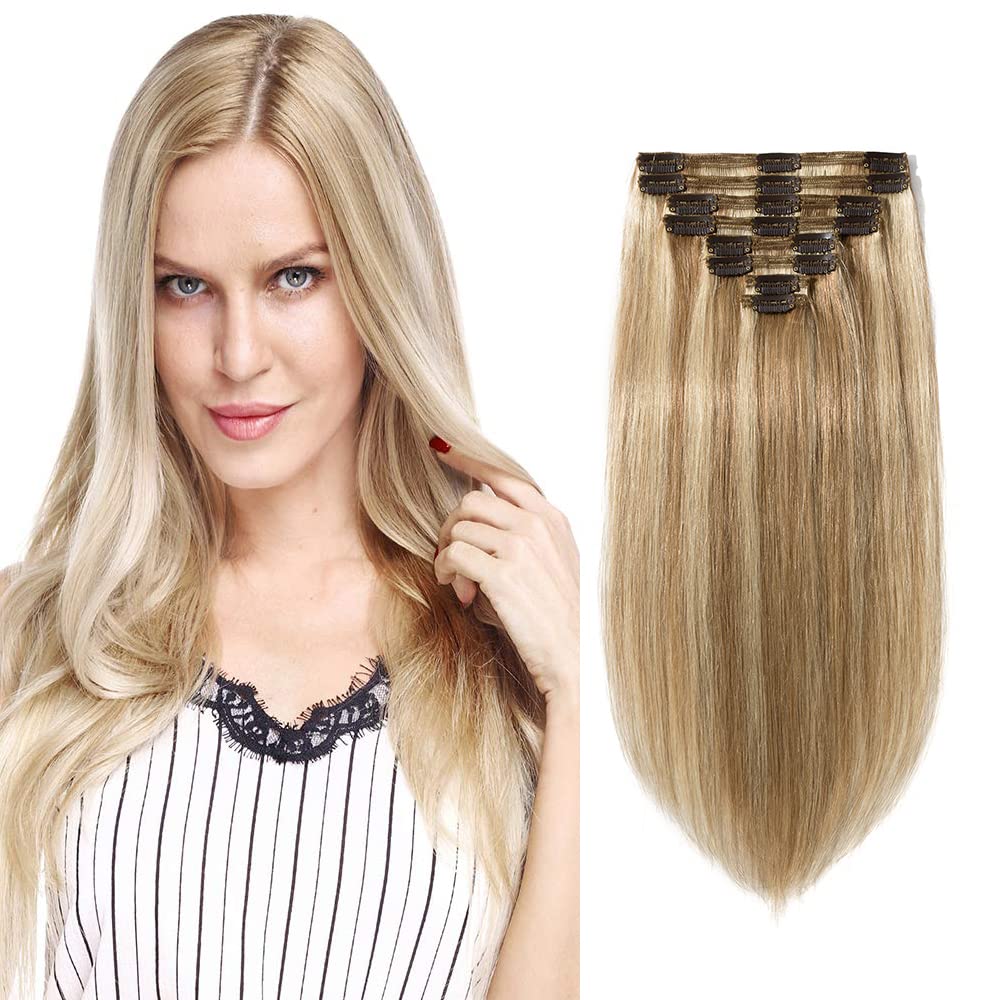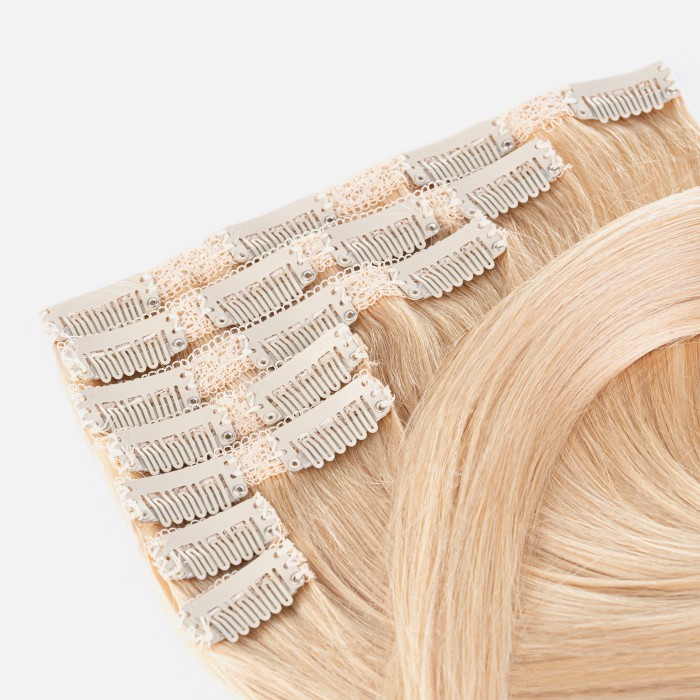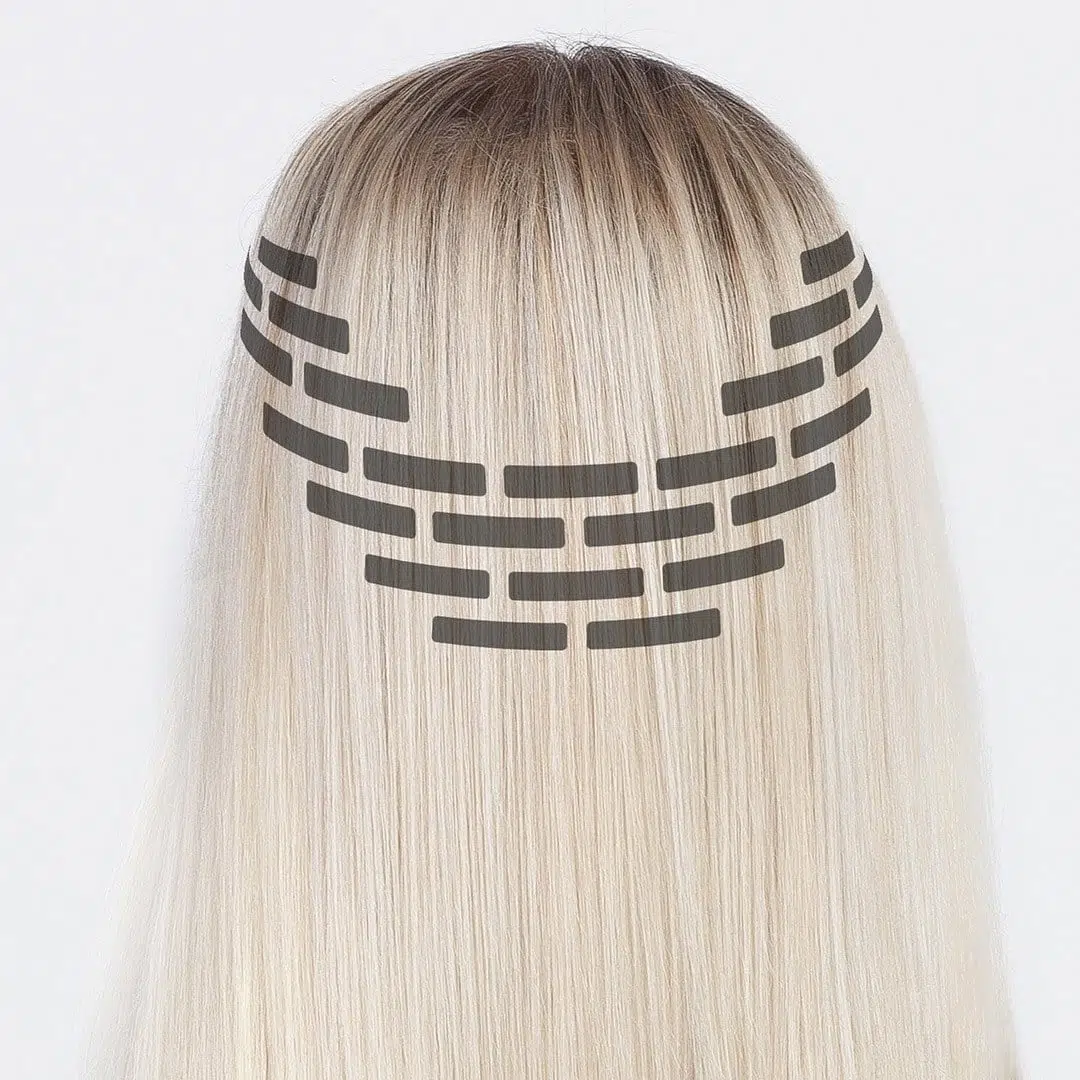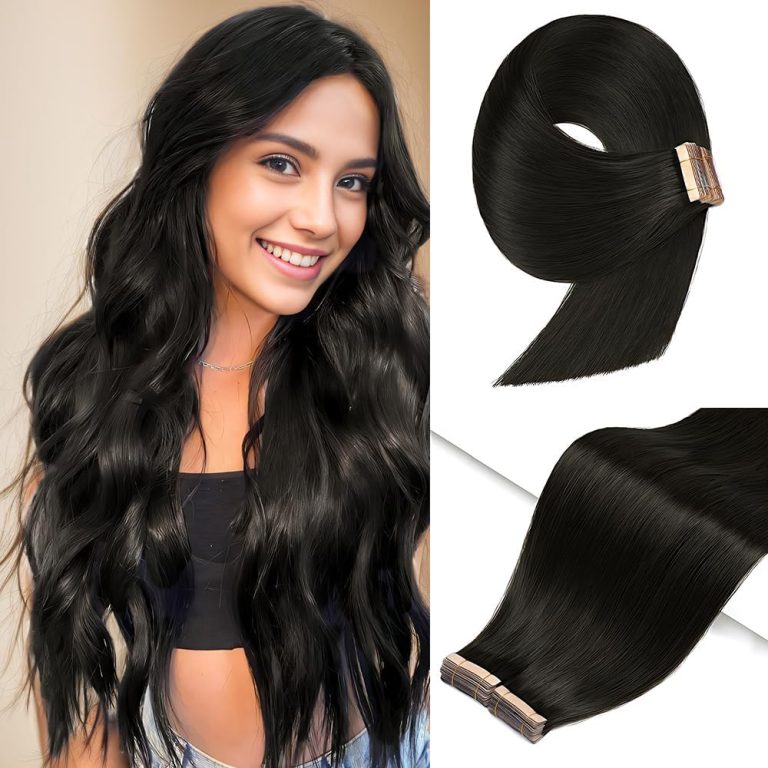
How Many Tape Extensions for Full Head: Achieving Beautiful Hair
When considering enhancing your hair volume and length, how many tape extensions for full head coverage becomes a crucial question. Tape extensions offer a seamless and natural look, but determining the right amount is essential to achieve the desired fullness without compromising the health of your natural hair. This comprehensive guide explores the factors influencing the number of tape extensions needed, ensuring you make an informed decision for a flawless and natural-looking result.
 Understanding Tape Extensions: An Overview
Understanding Tape Extensions: An Overview
Tape extensions have become a popular choice for those seeking to add length and volume to their hair. Unlike other extension methods, tape-ins are known for their discreet appearance and durability. These extensions are pre-taped to small sections of your natural hair, allowing for a secure and natural blend. But to achieve a full head of extensions, understanding how many tape extensions for full head is necessary.
What Are Tape Extensions?
Tape extensions consist of individual bundles of hair that are pre-attached to thin, double-sided adhesive tapes. During the installation process, small sections of your natural hair are sandwiched between the extension and the tape, creating a secure bond. This method ensures that extensions lie flat against the scalp, making them virtually undetectable.
Benefits of Tape Extensions
- Natural Appearance: Tape extensions blend seamlessly with your natural hair, providing a realistic look.
- Durability: When properly maintained, tape extensions can last up to 6-8 weeks.
- Versatility: They allow for various styling options, including washing, brushing, and heat styling.
- Comfort: Lightweight and non-intrusive, tape extensions do not cause discomfort or strain on the scalp.
Factors Influencing the Number of Tape Extensions for a Full Head
Several factors determine how many tape extensions for full head coverage you might need. These include your hair type, desired volume, density, and the specific goals you aim to achieve with extensions.
Hair Type and Texture
Your natural hair type and texture play a significant role in deciding the number of tape extensions required.
Straight Hair
Straight hair tends to lie flatter against the scalp, which means that achieving full coverage might require more extensions. Clients with straight hair often need additional tape extensions to ensure their hair looks full and voluminous.
Wavy Hair
Wavy hair has natural volume and body. Depending on the wave pattern, you might need fewer tape extensions to achieve a full head of volume. The texture helps the extensions blend more effortlessly, providing a balanced look.
Curly Hair
Curly hair can provide significant volume on its own, so the number of tape extensions needed may vary. It’s essential to avoid overloading curly hair with too many extensions, as this can lead to tangling and stress on your natural hair.
Desired Volume and Density
The level of volume and density you wish to achieve directly impacts the number of tape extensions required.
Natural Volume
If you’re looking to enhance your natural volume without drastic changes, a moderate number of tape extensions will suffice. This approach maintains a subtle and natural look.
Full and Voluminous Look
For a more dramatic and full appearance, you will need a higher number of tape extensions. This goal requires careful planning to ensure even distribution and avoid an overly bulky look.
Length of Extensions
The length of the tape extensions also affects how many you will need.
Short Extensions
Shorter extensions blend more easily with your natural hair and provide a more natural look. They often require fewer extensions to achieve full coverage.
Long Extensions
Long extensions might require more tape-ins to distribute the weight evenly and prevent strain on your natural hair. The additional length can create a fuller appearance, but careful application is necessary to maintain hair health.
Head Size and Shape
Everyone’s head size and shape are unique, which influences the number of tape extensions needed.
Larger Heads
Larger heads have more scalp area, necessitating more tape extensions to cover the entire surface adequately. This ensures that the extensions look proportionate and full.
Smaller Heads
Smaller heads require fewer tape extensions to achieve a balanced and natural look. It’s important not to underload, as this can lead to sparse areas.
Installation Technique
The expertise of the stylist and the installation technique can also impact how many tape extensions for full head are necessary.
Even Distribution
A skilled stylist will ensure an even distribution of extensions across the scalp, which might reduce the total number needed while still achieving full coverage.
Strategic Placement
Strategic placement focusing on high-traffic areas like the crown and sides can enhance volume without needing a large number of extensions.
 Estimating the Number of Tape Extensions Needed
Estimating the Number of Tape Extensions Needed
While individual requirements vary, there are general guidelines to help estimate how many tape extensions for full head coverage you might need based on your hair type, desired volume, and other factors.
General Guidelines
- Short to Medium Length: Typically requires 40-60 tape extensions for a full head of coverage.
- Long Length: May need 60-80 tape extensions to ensure the extensions blend seamlessly and provide adequate volume.
- Curly or Thick Hair: Often requires fewer extensions, around 30-50, as natural curls add volume.
- Thin or Fine Hair: May require more extensions, approximately 70-90, to achieve the desired fullness.
Personalized Consultation
Consulting with a professional stylist is the most accurate way to determine how many tape extensions for full head. They can assess your specific hair condition, discuss your goals, and provide a tailored recommendation.
Step-by-Step Installation Process
Understanding the installation process can help you better appreciate the factors influencing how many tape extensions for full head.
Step 1: Consultation and Hair Assessment
A thorough consultation involves evaluating your hair type, condition, and desired outcome. The stylist will discuss your goals and determine the appropriate number of tape extensions needed for full head coverage.
Step 2: Selecting the Right Extensions
Choosing the correct color, texture, and length of extensions is crucial. The stylist ensures the extensions match your natural hair to maintain a seamless blend.
Step 3: Preparing the Hair
Clean, dry, and detangle your hair to prepare for the application. The hair should be free of oils and product build-up to ensure the tape extensions adhere properly.
Step 4: Sectioning the Hair
The stylist sections the hair into small, manageable sections. This step ensures an even distribution of tape extensions across the entire scalp.
Step 5: Applying the Extensions
Each section is flattened and a tape extension is applied by securely placing it between the natural hair and the tape. This method ensures the extensions lie flat and blend naturally with your hair.
Step 6: Blending and Styling
Once all extensions are applied, the stylist will blend and style the hair to ensure a natural and full head of extensions. Proper styling enhances the overall look and ensures the extensions remain in place.
Maintenance Tips for Tape Extensions
Proper maintenance is essential to prolong the lifespan of your tape extensions and keep your hair healthy.
Regular Brushing
Brush your hair gently daily to prevent tangling and ensure the extensions remain evenly distributed. Use a soft-bristle brush to avoid pulling on the extensions and your natural hair.
Washing Instructions
When washing your hair, use sulfate-free shampoos and conditioners to protect the adhesive bonds. Avoid excessive rubbing and ensure the hair is thoroughly rinsed to prevent product buildup.
Avoiding Heat Damage
Limit the use of heat styling tools to prevent damage to both your natural hair and the extensions. When necessary, use heat protectant sprays to minimize potential harm.
Reapplying Extensions
Typically, tape extensions need to be reinstalled every 6-8 weeks. During this time, extensions maintain their appearance and functionality. Regular touch-ups keep the full head of extensions looking fresh and natural.
 Common Mistakes to Avoid
Common Mistakes to Avoid
Avoiding common mistakes can help you achieve the best results with your tape extensions.
Overloading Extensions
Applying too many extensions can strain your natural hair and scalp, leading to potential damage. It’s essential to follow professional recommendations on the number of extensions needed for full head coverage.
Improper Application
Incorrect application techniques can result in visible tape lines, tangling, and discomfort. Always seek the expertise of a professional stylist to ensure proper installation.
Neglecting Maintenance
Failing to maintain your extensions can reduce their lifespan and affect their appearance. Regular care and upkeep are vital for long-lasting and beautiful results.
Using Harsh Products
Using strong hair products can weaken the adhesive bonds and damage both the extensions and your natural hair. Opt for gentle, extension-friendly products to preserve the integrity of your extensions.
Benefits of Achieving a Full Head with Tape Extensions
Opting for a full head of tape extensions offers numerous advantages, enhancing both your appearance and confidence.
Enhanced Volume and Length
A full head of tape extensions provides immediate volume and length, transforming your hairstyle effortlessly. This can boost your confidence and allow you to experiment with different looks without altering your natural hair.
Versatility in Styling
With a full head of extensions, you have greater flexibility in styling your hair. Whether you prefer straight, wavy, or curly styles, extensions allow you to achieve various looks with ease.
Protection for Natural Hair
Extensions can act as a protective layer for your natural hair, reducing exposure to environmental damage and heat styling. This promotes healthier hair growth and minimizes breakage.
Boosted Self-Esteem
Achieving a fuller head of hair can significantly enhance your self-esteem and overall appearance. Feeling confident in your hair can positively impact other areas of your life, from personal relationships to professional interactions.
 Cost Considerations
Cost Considerations
Understanding the cost involved in achieving how many tape extensions for full head is crucial for budgeting and planning.
Initial Installation Costs
The initial cost of tape extensions depends on the number of extensions required, the quality of the hair, and the expertise of the stylist. Generally, a full head installation can range from 200to600, depending on these factors.
Maintenance Costs
Ongoing maintenance is necessary to keep your extensions looking their best. This includes periodic touch-ups, professional cleanings, and potential repairs, which can add to the overall cost.
Quality vs. Affordability
Balancing quality and affordability is essential. Investing in high-quality extensions may have a higher upfront cost but offers better durability and a more natural look. Conversely, opting for more affordable options might save money initially but may require more frequent replacements.
DIY vs. Professional Installation
Deciding whether to install tape extensions yourself or seek professional help impacts both the outcome and the number of extensions needed.
Professional Installation
Choosing a professional ensures a precise and even application, which is crucial for achieving a full head of extensions. Professionals can accurately assess how many tape extensions for full head you need and apply them correctly to ensure longevity and a natural look.
DIY Installation
While DIY installation can save money, it requires a certain level of skill and practice. Improper installation can lead to visible tape, uneven coverage, and potential damage to your natural hair. If you choose the DIY route, ensure you follow detailed instructions and use high-quality extensions to minimize risks.
Alternatives to Tape Extensions
While tape extensions are a popular choice, exploring alternatives can help you find the best option for your needs.
Clip-In Extensions
Clip-in extensions are removable and versatile, allowing for temporary changes in length and volume. They offer flexibility but may not provide the same seamless look and long-lasting wear as tape extensions.
Sew-In Extensions
Sew-in, or weft extensions, are attached by braiding the natural hair and sewing the extensions onto the braids. They offer durability and a natural appearance but require a skilled stylist for proper installation and maintenance.
Micro-Link Extensions
Micro-link extensions involve attaching small sections of extensions to individual strands of hair using tiny beads. They are durable and allow for more movement but can be time-consuming to install and remove.
Fusion Extensions
Fusion extensions use a keratin-based adhesive to bond extensions to the natural hair. They provide a secure and long-lasting hold but require professional installation and can be more expensive.
Choosing the Right Extension Type for Your Needs
Selecting the right extension type depends on your lifestyle, budget, and desired outcome. Understanding the differences between tape extensions and other methods can help you make an informed decision.
Lifestyle Considerations
If you lead an active lifestyle and prefer low-maintenance solutions, tape extensions offer durability and ease of care. However, if you prefer flexibility and frequent changes in your hairstyle, clip-in extensions might be more suitable.
Budget Constraints
Tape extensions offer a balance between cost and quality. While they are more expensive than some temporary options like clip-ins, they provide a longer-lasting solution without the high costs associated with other permanent methods.
Styling Preferences
Consider how you like to style your hair. Tape extensions allow for a wide range of styling options, including heat styling and coloring, without significant restrictions.
 Health and Safety Considerations
Health and Safety Considerations
Maintaining the health of your natural hair is paramount when using extensions. Understanding the impact of how many tape extensions for full head can help you avoid potential damage.
Preventing Hair Breakage
Overloading your hair with too many extensions can lead to breakage and thinning. It’s essential to follow professional recommendations to ensure your natural hair remains healthy and strong.
Scalp Health
Maintaining a healthy scalp is crucial. Proper installation and maintenance of tape extensions prevent buildup of oils and debris, reducing the risk of scalp irritation and dandruff.
Proper Removal
Removing tape extensions correctly is vital to prevent damage to your natural hair. Avoid pulling or yanking the extensions, and seek professional help if you’re unsure how to remove them safely.
Final Thoughts
Deciding how many tape extensions for full head coverage depends on various factors including your hair type, desired volume, length, and personal preferences. By understanding these elements and consulting with a professional stylist, you can achieve a full, natural-looking head of extensions that enhances your beauty and confidence.
Tape extensions offer a versatile and effective solution for those seeking to improve their hair’s appearance. Whether you aim for subtle volume or dramatic length, getting the right number of extensions ensures a balanced and stunning result. Remember to prioritize quality and maintenance to enjoy the benefits of tapes extensions for as long as possible. Embrace the transformation and let your hair shine with the perfect full head of tape extensions, tailored to meet your unique needs and style.

